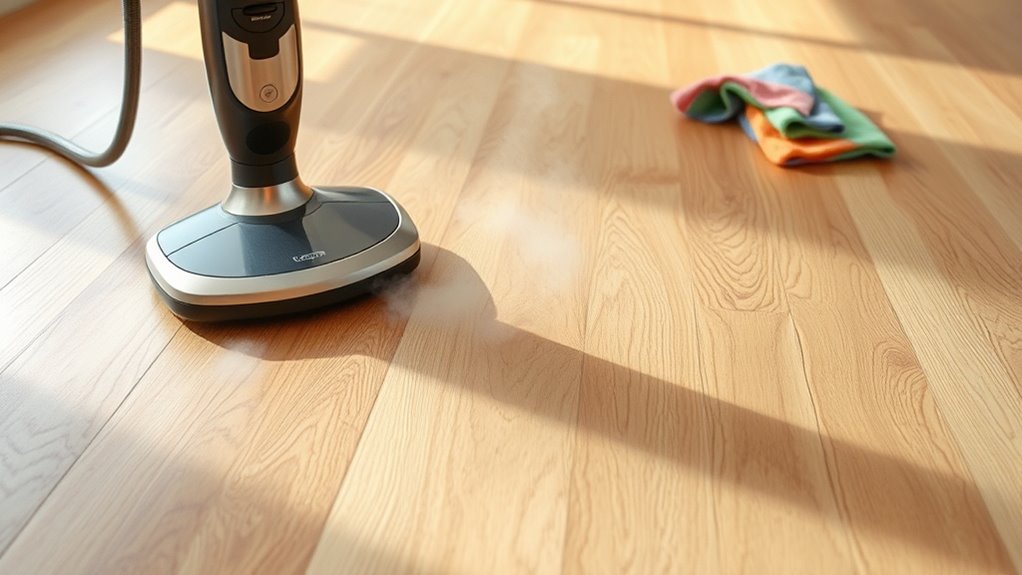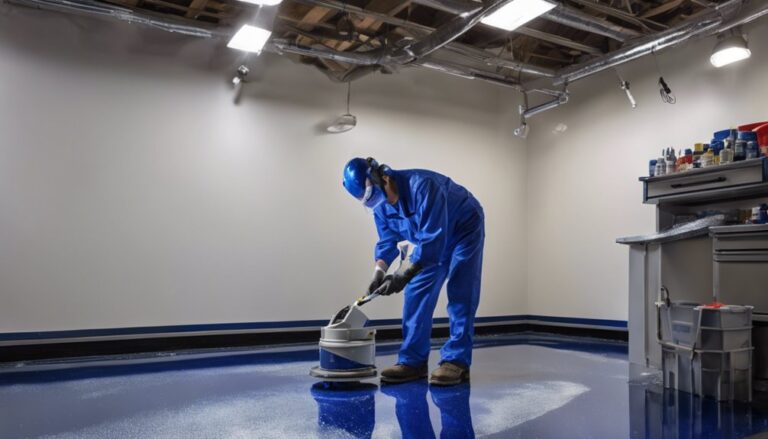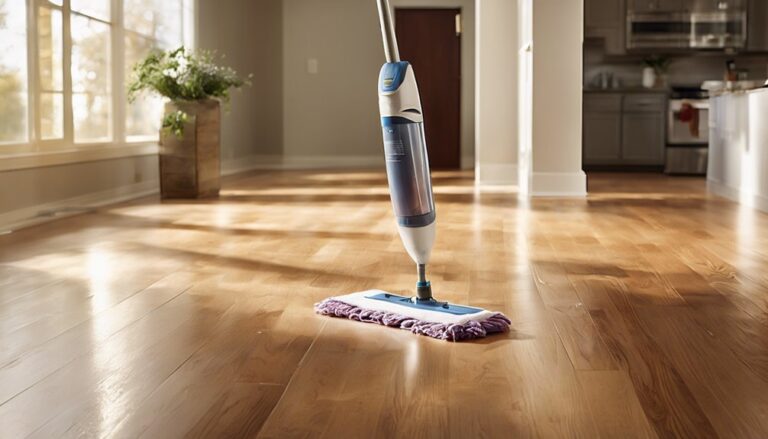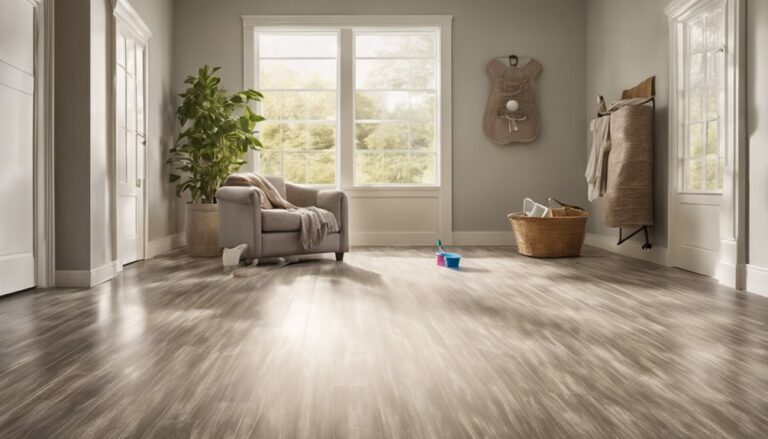You shouldn’t steam clean laminate floors because the high heat and moisture can damage their protective melamine coating, leading to swelling, warping, and peeling. Laminate’s core readily absorbs water, compromising structural stability and causing adhesive failure between planks. Most manufacturers advise against steam cleaning to avoid voiding warranties. Instead, use damp mopping with pH-neutral cleaners. If you want to protect your floor’s longevity, it helps to understand preparation, safe cleaning methods, and damage signs first.
Understanding Laminate Flooring Composition

Laminate flooring consists of multiple layers designed to provide durability, aesthetic appeal, and ease of installation. When you examine laminate materials, you’ll find a top wear layer made of transparent melamine resin, which protects against scratches and stains, ensuring long-term sol durability. Beneath that, a high-resolution photographic layer mimics the look of wood or stone, giving you the freedom to choose styles without compromising function. The core layer, typically high-density fiberboard (HDF), provides structural stability and resistance to impact. Finally, a backing layer adds moisture resistance and balances the board to prevent warping. Understanding these layers helps you appreciate why laminate floors are engineered for resilience and design versatility, allowing you to maintain a durable floor that fits your lifestyle without excessive upkeep.
How Steam Cleaning Works
When you use a steam cleaner, it heats water to create high-temperature steam that penetrates surfaces, loosening dirt and grime without chemicals. The combination of heat and moisture sanitizes and lifts debris, making it effective for cleaning hard floors. However, understanding how this process interacts with laminate flooring materials is essential for proper care and avoiding damage.
Steam Cleaning Mechanism
Although steam cleaning is often praised for its efficiency, understanding how it works is essential before applying it to delicate surfaces. The mechanism relies on high-temperature steam to clean effectively while minimizing chemical use, which aligns with steam cleaning benefits and laminate floor maintenance. Here’s how it operates:
- Water is heated to produce steam at temperatures typically above 212°F (100°C).
- The steam is released under pressure through a nozzle, targeting dirt and grime.
- Heat from the steam loosens debris and kills bacteria without abrasive scrubbing.
- The moisture evaporates quickly, leaving surfaces mostly dry.
Heat and Moisture Effects
Understanding how heat and moisture interact with laminate flooring is key to evaluating steam cleaning’s suitability. When you expose laminate floors to steam, the high temperature generates moisture that penetrates the surface. Laminate flooring consists of a fiberboard core vulnerable to moisture retention, which can cause swelling, warping, or delamination. Steam exposure introduces both heat and water vapor, increasing the risk of these damages. The protective wear layer on laminate isn’t fully waterproof, so excessive moisture can seep through seams or edges. This compromises the structural integrity and appearance over time. Consequently, you must consider how steam’s heat accelerates moisture absorption, leading to potential long-term harm. Understanding these interactions helps you decide whether steam cleaning aligns with your flooring maintenance goals and freedom from damage.
Benefits for Floor Care
Steam cleaning harnesses high-temperature vapor to break down dirt, grime, and bacteria without relying on harsh chemicals. This method offers distinct benefits for laminate floor care when applied with the right cleaning techniques and maintenance tips:
- Effective Sanitization: The steam’s heat kills germs and allergens, promoting a healthier environment without residue.
- Gentle Cleaning: It loosens debris without abrasive scrubbing, preserving laminate’s protective layer.
- Séchage rapide: Vapor evaporates rapidly, reducing moisture exposure that can warp or damage flooring.
- Eco-Friendly Approach: By avoiding chemical cleaners, you minimize environmental impact and indoor pollution.
Using steam cleaning correctly supports your laminate floor’s durability and appearance, ensuring you maintain freedom from harsh products while extending your floor’s lifespan. Always combine this with manufacturer-recommended maintenance tips for ideal results.
Potential Risks of Steam Cleaning Laminate Floors
You need to be cautious with steam cleaning because excessive moisture can penetrate laminate seams, leading to water damage. This exposure may cause the boards to warp or swell, compromising the floor’s integrity. Additionally, high heat and steam can degrade the protective coating, reducing its effectiveness over time.
Water Damage Concerns
Although steam cleaning can be an effective method for sanitizing floors, laminate flooring is particularly susceptible to water damage due to its composite wood core. When you use steam cleaners, excessive moisture poses several concerns:
- Water absorption: Laminate’s core readily absorbs water, compromising structural integrity.
- Moisture retention: Trapped moisture beneath the surface can promote mold and mildew growth.
- Seams vulnerability: Water can penetrate between planks, weakening adhesive bonds.
- Finish degradation: Repeated exposure to steam may dull or damage the top wear layer.
You want to avoid these risks to maintain your floor’s durability and appearance. Understanding how water interacts with laminate is essential before opting for steam cleaning, as this method often introduces more moisture than traditional mopping, increasing potential damage.
Warping and Swelling Risks
When moisture penetrates laminate flooring, it often causes the core materials to absorb water and expand, leading to warping and swelling. Steam cleaning introduces high humidity and heat, both significant swelling factors that compromise the laminate’s dimensional stability. If you want effective warp prevention, it’s essential to minimize moisture exposure and avoid steam directly on the floor surface. The laminate’s fiberboard core is particularly vulnerable, as it lacks waterproofing, making it prone to irreversible deformation. Even brief, repeated steam applications can accumulate moisture, increasing the risk of gaps, buckling, and surface irregularities. To maintain your laminate’s integrity and freedom from damage, consider alternative cleaning methods that reduce moisture infiltration, thereby controlling swelling factors before warp prevention becomes a costly necessity.
Protective Coating Effects
Since laminate floors rely on a protective coating to shield the surface from scratches and moisture, applying steam can compromise this layer’s integrity. When you use steam cleaning, you risk diminishing the protective benefits the coating provides. Here’s what you need to take into account:
- High heat and moisture from steam can degrade coating durability, causing it to wear prematurely.
- Damaged coating reduces resistance to stains and surface scratches, exposing the laminate underneath.
- Once compromised, the floor becomes more vulnerable to moisture infiltration, accelerating swelling and warping.
- Repairing or reapplying the protective layer isn’t feasible, leading to costly replacements.
To maintain your laminate’s freedom from damage, avoid steam cleaning and opt for methods that preserve the coating’s protective benefits and long-term durability.
Benefits of Using a Steam Cleaner on Laminate
If you want an efficient way to sanitize and clean your laminate floors without harsh chemicals, using a steam cleaner offers several advantages. The steam cleaner advantages include deep cleaning through high-temperature vapor, which kills bacteria and removes grime without damaging the protective coating. This method preserves laminate floor benefits such as maintaining surface integrity and enhancing longevity.
| Avantage | Description | Impact on Laminate Floors |
|---|---|---|
| Chemical-Free | Uses water vapor instead of detergents | Prevents residue buildup |
| Deep Sanitization | High heat kills germs and bacteria | Promotes a hygienic environment |
| Séchage rapide | Minimal moisture exposure | Reduces risk of water damage |
| Écologique | Low energy and water usage | Supports sustainable cleaning habits |
Manufacturer Recommendations and Warnings

You should always check your laminate floor manufacturer’s guidelines before using a steam cleaner, as many explicitly advise against it. Brands often warn that excessive moisture and heat can warp or delaminate the flooring. Ignoring these warnings could void your warranty and leave you responsible for damage repairs.
Common Manufacturer Guidelines
Although laminate flooring offers durability and aesthetic appeal, most manufacturers strongly advise against using steam cleaners on their surfaces. Heeding manufacturer advice guarantees you protect your investment and maintain the floor’s integrity. Common guidelines stress that:
- Excess moisture from steam can penetrate seams, causing swelling and warping.
- High heat may degrade the protective wear layer, reducing lifespan.
- Recommended cleaning techniques favor damp mopping with pH-neutral solutions.
- Avoid abrasive tools or harsh chemicals that compromise the laminate’s finish.
Risks Highlighted by Brands
Since laminate floors are engineered with multiple layers bonded together, manufacturers caution against steam cleaning due to the risk of moisture infiltration that can cause irreversible damage. The high temperature and steam can penetrate the seams, causing swelling, warping, or delamination. Brands emphasize that even brief exposure to excessive moisture compromises the core board’s integrity. They warn that steam cleaning may void product warranties because it conflicts with recommended maintenance practices. Instead, they advocate for damp mopping with minimal water to preserve the laminate floor’s structure. If you value freedom in maintaining your floors, it’s essential to heed these warnings to avoid costly repairs. Manufacturers highlight that the risks linked to steam cleaning far outweigh the convenience it might offer.
Warranty and Damage Clauses
When steam cleaning is used on laminate floors, manufacturers often include specific warranty and damage clauses that disallow coverage for moisture-related issues. You should understand these warranty limitations to avoid voiding your protection. Here’s what to take into account:
- Warranty limitations typically exclude damage caused by excessive moisture or steam exposure.
- Damage claims for warped, swollen, or delaminated flooring are usually denied if steam cleaning was involved.
- Manufacturers advise against using steam mops or similar devices, explicitly stating this in user manuals.
- Any alteration or misuse that leads to moisture penetration can nullify your warranty rights.
Alternative Cleaning Methods for Laminate Floors

Maintaining laminate floors requires choosing cleaning methods that protect their finish and structural integrity. Instead of steam cleaning, consider using eco friendly solutions like diluted white vinegar or gentle dish soap mixed with water. These DIY cleaners effectively remove dirt without introducing excessive moisture that can warp the laminate. Use a microfiber mop to apply the solution lightly and guarantee quick drying. Avoid abrasive tools or harsh chemicals that could degrade the protective wear layer. Regularly sweeping or vacuuming with a soft brush attachment also preserves your floor’s surface by preventing grit buildup. By selecting these alternative cleaning methods, you maintain both the aesthetic and durability of your laminate flooring, granting you the freedom to keep your space clean without compromising its longevity.
Preparing Your Laminate Floor for Cleaning
Before you begin cleaning your laminate floor, it’s essential to prepare the surface properly to avoid damage and guarantee effective results. Proper cleaning preparation guarantees your floor maintenance routine preserves both appearance and durability. Follow these steps:
- Remove all furniture and rugs to access the entire floor surface.
- Sweep or vacuum thoroughly to eliminate dust, dirt, and debris that could scratch during cleaning.
- Inspect the floor for any damage, such as cracks or lifting edges, and address these before proceeding.
- Confirm the floor is dry; excessive moisture prior to cleaning can compromise laminate integrity.
Step-by-Step Guide to Safely Steam Clean Laminate
Although steam cleaning laminate floors requires caution, following a precise method guarantees effective cleaning without damage. Start by selecting a steam cleaner with adjustable steam levels suited for delicate surfaces. Fill the unit with distilled water to prevent mineral buildup. Attach a microfiber pad to avoid direct steam contact with the floor. Begin in a corner, moving the cleaner slowly and evenly, using minimal steam to prevent moisture infiltration. Avoid saturating seams, which compromises laminate floor care. After steam cleaning, immediately dry the surface with a clean microfiber cloth to eliminate residual moisture. Regularly inspect and maintain your equipment for consistent steam cleaning techniques. This approach balances thorough cleaning with laminate protection, letting you enjoy a pristine floor without risking warping or swelling.
Signs of Damage After Steam Cleaning
If you notice any irregularities after steam cleaning your laminate floors, it’s crucial to identify signs of damage early to prevent further deterioration. You should watch for:
- Visible signs of discoloration—uneven fading or dark spots indicate moisture absorption.
- Surface peeling or bubbling—this suggests the laminate’s protective layer is compromised.
- Warping or swelling—boards may expand due to trapped steam moisture.
- Cracking or splitting—excessive heat can weaken the laminate’s structure.
Promptly spotting these signs of damage helps you avoid costly repairs or replacement. Keep in mind that laminate floors are engineered to resist moisture, but steam cleaning can exceed those limits, causing irreversible harm. If you detect any of these issues, discontinue steam cleaning immediately to preserve your floor’s integrity and appearance.
Maintaining Laminate Floors for Longevity
To guarantee your laminate floors remain durable and visually appealing, you’ll need to adopt a consistent maintenance routine that controls moisture exposure, prevents surface abrasion, and addresses spills promptly. Employ cleaning techniques that use a damp mop rather than excessive water, as standing moisture can cause warping. Avoid harsh chemicals; instead, select pH-neutral cleaners designed specifically for laminate surfaces. Regularly sweep or vacuum to eliminate abrasive particles that can scratch the floor’s finish. Implement floor maintenance practices such as using protective pads under furniture and promptly wiping spills to prevent staining. By following these precise cleaning techniques and maintenance strategies, you’ll extend your laminate floor’s lifespan while preserving its aesthetic, ensuring you maintain both freedom from frequent repairs and a pristine living environment.




